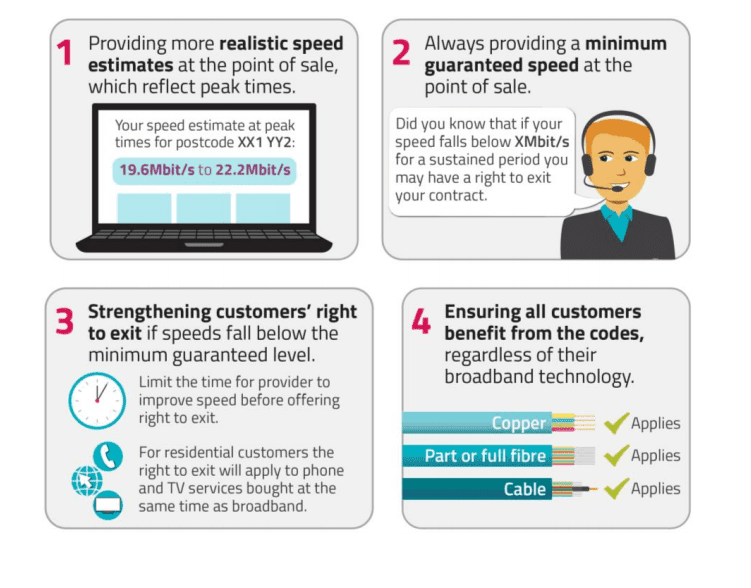Many of the UK's biggest broadband providers are signed up to a code of practice with industry regulator Ofcom, which ensures customers are given minimum speed guarantees.
While the code is voluntary, for those signed up, a customer is given the right to exit their contract penalty free if they don't get the promised speeds.
However, despite this code, there is still no mechanism to allow customers to pay less for slow broadband speeds, although it can still be worth complaining to see what can be done.

Can I pay less if I get slow broadband?
It's not currently possible to pay less for broadband simply for getting a slower speed than we might have expected when we signed up. So, demanding a discounted price because our broadband isn't as fast as we'd like is unlikely to work.
However, customers with some providers should have been given a minimum guaranteed download speed when they signed up.
If customers go on to experience slower speeds than the minimum they were guaranteed, and the provider doesn't resolve the issue within 30 days, they're entitled to leave their contract without penalty and find another deal elsewhere.
Better Broadband Speeds
Ofcom's voluntary code of practice on Better Broadband Speeds helps to provide assurances of broadband speeds as well as protection when speeds become particularly slow.
As part of the code, providers are required to supply customers with the following additional information when they sign up for a broadband deal:
- Minimum guaranteed broadband speed
- Personalised estimate speeds based on an individual property
Providers also promise that if a customer's broadband speed falls below the minimum guaranteed speed and they don't resolve the issue within 30 days of being notified, they will let the customer leave their contract without paying any early termination fees.
There are two main benefits to this code of practice for customers:
- Clearer and more transparent information about the service provided to help customers compare different offers
- Service-level guarantees and protection if the actual speed received by a customer drops below a minimum level given at the point of sign up
However, as a voluntary code, broadband providers aren't forced to do this, and so far, only the below providers have signed up:
- BT
- EE
- NOW Broadband
- Plusnet
- Sky
- TalkTalk
- Utility Warehouse
- Virgin Media
- Zen Internet
Vodafone, as well as a number of smaller independent full fibre networks such as Hyperoptic and Community Fibre, are notable exceptions. Although, despite this, Hyperoptic still offer customers a minimum guaranteed speed on all their packages.
We can also compare the minimum speed guarantees across providers, to see who is promising the fastest broadband connection.
Taking 100-150Mb full fibre broadband packages as an example, the minimum speed guarantees coming with these plans are:
| Average download speed | Minimum guaranteed download speed | |
|---|---|---|
| BT | 150Mb | 100Mb |
| Hyperoptic | 150Mb | 150Mb |
| NOW | 100Mb | 90Mb |
| Plusnet | 145Mb | 80Mb |
| Sky | 150Mb | 100Mb |
| TalkTalk | 150Mb | 120Mb |
| Virgin Media | 132Mb | 66Mb |
| Vodafone | 150Mb | 75Mb |
Note: This is an example only, as minimum guaranteed download speeds can vary between individual properties and locations.
It's notable the difference between some providers, even those operating on the same underlying wholesale network. So, it can be worth considering the minimum speed guarantees and our personalised estimates when we sign up for a broadband deal.
Ofcom's broadband speed rules
While the broadband speeds code of practice was last updated in September 2022, the biggest change to the code came in 2018, when Ofcom strengthened and updated the rules to ensure customers were better protected and could exit their contracts if they received slow speeds.
Now the rules ensure that customers get:
1. More realistic speed estimates
Customers receive personalised speed estimates based on their individual property. These estimates should also be based on peak time speeds, between 8pm and 10pm in the evening when networks are busiest.
Providers are also required to tell customers these speed estimates 'at the point of sale', which means during the buying process - before a customer has handed over any money or signed the contract.
2. Minimum guaranteed download speeds
While broadband providers must now only advertise download speeds that at least 50% of their customers receive at peak times, minimum guaranteed download speeds go one step further.
The minimum guaranteed speed is an effectual worse-case scenario, or in other words, a service guarantee. A provider promises to deliver at least this minimum speed or customers are granted the right to leave their contracts penalty free.
3. Strengthened rights to exit the contract
If customers don't receive the minimum guaranteed download speed and the provider doesn't resolve the issue within 30 calendar days (i.e. not working days) of being notified, they must be allowed to exit their contract without penalty or any early termination fees.
It's also now the case that these cancellation rules apply to any linked services, such as home phone or TV plans, included in the bundle, so customers aren't caught out by being able to cancel the broadband but not additional services they purchased at the same time.
Providers should be highlighting the rules around the right to exit, both in pre- and post-sales information, and that this right to exit is clearly linked to the minimum speed guarantee.
4. Ensuring all customers benefit
Previously, the code of practice on broadband speeds only applied to networks using copper and part-fibre connections. However, since 2018, the rules also apply to full fibre to the home and cable broadband packages.

Are minimum speed guarantees working to protect customers?
Ofcom reported on the changes made to the broadband speeds code of practice in 2022 and found that providers who had joined the code were meeting the requirements and therefore consumers were being protected as they had intended.
The regulator found that:
- Two thirds of broadband customers were covered by the code due to the number of large providers signed up
- Customers were being provided with clear and realistic information about their broadband speeds at the point of sale
- 95% of broadband speed issues were resolved within the 30-day limit provided by the rules
- Of the remaining 5%, most customers were offered ways to resolve their issues, with 20% of this group choosing to exit their contract or choosing an alternative solution
So, Ofcom's code of practice on broadband speeds, including the minimum speed guarantee, is working to protect customers - as long as providers are signed up to the voluntary code.
Should customers be able to pay less for slow broadband?
While the minimum speed guarantee is shown to be working for customers, and it's worthwhile for those comparing broadband deals to know about and check, there are instances where protection against slow broadband speeds doesn't work as well as it perhaps should.
For example, slow broadband could be the result of a property's location and the connections available to them. Switching provider in these cases, especially where a home is only covered by one wholesale network, may not magically improve broadband speeds.
This kind of scenario is becoming less of an issue with the rollout of full fibre broadband, which now covers 69% of homes and is much less affected by distance or property location.
However, where a customer only has access to one network, e.g. copper or fibre to the cabinet with Openreach, it does raise the question of fairness for those stuck with slow broadband and whether they should be entitled to pay less.
Arguments against discounts for slow broadband
Pricing by speed, as fair as it might seem, would be complicated.
An across-the-board discount for homes that receive average speeds under a certain level might work - but the bar would have to be very low to make that financially feasible for broadband providers.
At this point, customers might be better off waiting for minimum speed regulations, as paltry they might be.
Perhaps, then, pricing by speed could be done in tiers?
Again, the hitch is cost. Offering cookie-cutter packages for broadband saves providers an immense amount of money. It is unlikely that regulators would force them to shell out on complex pricing systems.
In addition, the reasons broadband runs slowly might be connected to obstacles inside the home rather than anything to do with the provider at all. Under those circumstances, providers would hardly be amenable to charging less.
Is my broadband speed acceptable?
Many broadband customers would argue that the only acceptable broadband speed is the one they signed up for.
However, under advertising rules, providers can use an average speed in their adverts as long as it can be achieved by at least 50% of customers at peak times (8pm to 10pm).
What this means, though, is that up to half of all customers may not receive the average speed - and some could receive significantly below that.
What speeds are we getting?
Ofcom data tells us how many premises across the UK can access the different levels of broadband speeds.
As of December 2024, these were the figures across the whole of the UK:
| Broadband | Coverage as of December 2024 |
|---|---|
| At least 10Mb | 99.8% |
| Superfast | 98% |
| Gigabit-capable | 83% |
| Full fibre | 69% |
More recent estimates from ThinkBroadband put the level of full fibre coverage at 73% and gigabit-capable coverage at 85%, suggesting the Government has already met their target of 85% gigabit coverage by 2025.
However, just because four-fifths of us have access to gigabit-capable broadband, mainly through Virgin Media's Gig1 rollout, that doesn't mean we're all signing up to 1Gb speeds.
For example, while 98% of the UK theoretically have access to superfast broadband of 30Mb or above, only 75% had signed up to a superfast or faster package by 2024. In addition, while full fibre coverage has passed almost 70% of homes, currently only 35% of those with full fibre availability have made the switch.
The national average download speed taken by homes passed 50Mb in 2018 and rose again to more than 80Mb in tests conducted in 2020, while Ofcom's official figure now sits at 223Mbps as of 2024.
So, home broadband speeds are getting faster for many, even if there is a small number of households who can't access the supposed UK guaranteed minimum speed of 10Mb.
Universal Service Obligation (USO)
Since March 2020, households that can't receive an 'affordable' 10Mb-or-more connection can request a better line from BT or KCOM (in Hull).
The USO means those providers must connect customers to the network unless it would cost more than £3,400 to do so.
Following an investigation from Ofcom, BT agreed to change their methodology to ensure that houses in communities where multiple households would benefit from the USO without having to pay high costs for the installation.
That said, the USO is still capped and BT can still reject a request.
The percentage of homes and businesses eligible under the USO as of December 2024 was just 0.2%.
Note: The USO meant an end to the previous Better Broadband Scheme that helped rural households achieve minimum speeds of 2Mb.
Summary: Check minimum speed guarantees
Customers with broadband providers who are signatories to the Voluntary Code of Practice on Better Broadband Speeds are in the best position when it comes to getting a decent broadband speed.
These customers will receive a minimum speed guarantee at sign-up and they can hold their provider to that - with caveats:
- The minimum guaranteed speed is generally less than the average advertised speed
- The speed is the line speed at the router, and not the speed as registered by any connecting devices in the home either wired or wirelessly
- Customers must give their provider 30 days to resolve the issue before they can exit their contract, and some providers will require a 14-day 'settling-in' period on new connections to allow the line to 'settle'
Overall, these codes of practice seem to be working well for customers, yet there is still no mechanism for getting the average speeds we signed up for.
While those must be available to at least 50% of households at peak times, there's no way of making sure providers stick to that for our household.
If we're not getting the speeds we signed up, it's still worth making a broadband complaint and it could be that a company's tech support will be able to address our broadband connection issues.
One possible solution is switching to a lower-cost package that more accurately reflects what speeds the household is getting - but this will have to be negotiated with the provider.
Remember, as ever, to be polite with broadband call centre staff, no matter how frustrating the issue is. Solutions are more likely to be forthcoming if we're cooperative and explain our issues calmly.
We also have more information on how to improve broadband speeds and what different broadband speed definitions mean in these guides.









Comments